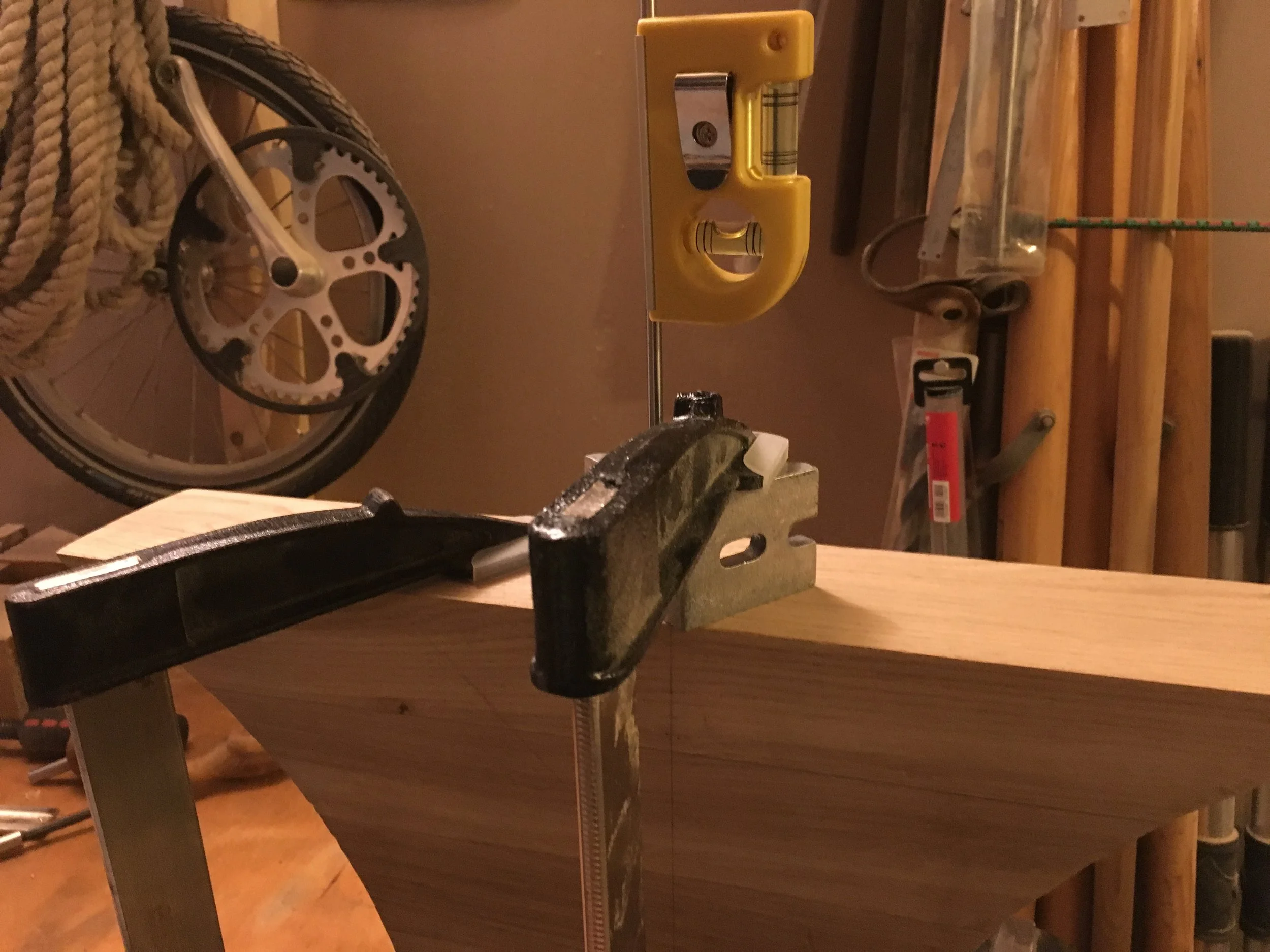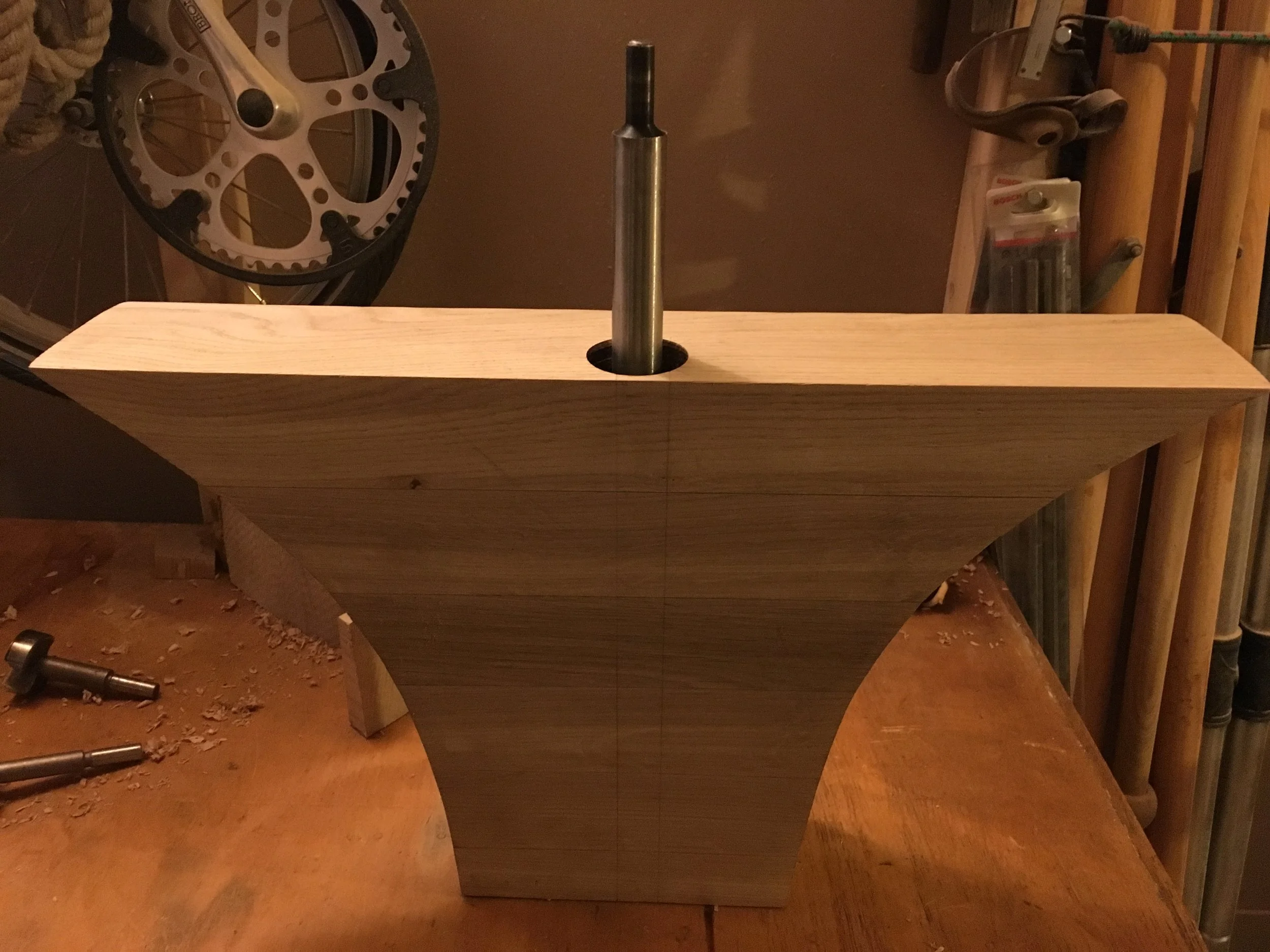Floor #3 - drilling
The time has come to drill through this new floor timber. Adventure in itself - even though I have a guiding hole started on the bottom I still need to be sure that the bolt will exit the timber straight on the top surface.
After careful measurements I’ve transferred desired exit position to the top face. To have it started on this side I’ve used spade drill. The plan was then that I will use drill press to drill all the way down, using top, shallow hole as a guide.
Nope! This huge drill press to which I have access was too small to accommodate the timber!
Left on my own I decided to make a guiding jig from some scrap metal. The idea was that I will use this jig to drill half-way down the timber from each side. If the drill wanders a bit inside I still will have entry and exit holes well defined. Starting with 5mm pilot drill should give guiding for bigger drills which, in theory, will straighten the channel as they follow the easiest path along the pilot hole.
The fixture is made from scrap aluminium pieces. Using drill press I’ve drilled 5,05mm guiding holes for 5mm drill.
I’ve levelled everything and clamped tightly so that nothing moves when I start drilling.
Off I went - drilling relatively slowly as it is very dense wood, with almost no pressure on the drill to prevent it from wandering and overheating. After reaching half way I turned the timber, aligned again everything and repeated the same from the other side until I felt that both holes have met.
Then went bigger drills, gradually increasing size from 5 to 20mm.
After reaching 18mm I already knew that this is not working as I hoped. The hole was still bent, a wormhole of a kind. I could now see this slight bend and bigger diameter drills just followed it while removing wood. I think that the problem was that these extra-long drills are not fully-bodied but instead they sit on long but thinner shaft which allows them to slightly bend.
For final drilling I got proper drill which is very stiff and heavy. I should have used that kind of drill from the start.
This guy did not follow the hole but behaved like the final keel bolt will behave - went through it without noticing my desperation. In the end I got oval-shaped entry and exit openings. Not by huge amount but still far from perfect.
Finally it sits as it should but it is not a tight fit which I struggled for. The shabby work will not be visible after installation and will not compromise the function of this part but I KNOW IT IS THERE!
Contingency plan? I have two:
Fill the excess space around the bolt with thin epoxy
Use this timber as a pattern and make a new one
As much as I like the second option I don’t think I’ll manage before spring: there are other urgent jobs to attend on Meritaten before I can put her into water.
The plan #1 is not that bad anyway - to prevent rust caused by tannin acid in oak I planned to cover my new keel bolts with epoxy. If I would have tight fit in this timber that would yield almost impossible.
Well - now I have enough space to pour the resin there indeed!
I’m not worried that it will not work. After all, epoxy joints are always stronger that the wood which they connect. As long as one does not screw up the proportions and temperature this stuff is really strong.
To test that anyway I tried separating the joints in offcuts from this floor timber.
As expected - it was oak which failed first, epoxy joint kept itself intact.
The problem I have with any glue joint is that it has a limited lifespan after which the joint fails.
We know already now that cold moulded boats are still in good condition after 40 years. But still no one knows how long epoxy joint will hold. My boat was glued with Cascoflex during assembly. It is a very good glue, water resistant and withstanding boiling test but still the shipyard used traditional mechanical fastenings (copper rivets) to keep planks on frames movable and mechanically connected should the glue fail.
Well, after 60 years there is not much of this glue left in my boat. She is now fully traditional plank-on-frame construction but still watertight due to being mechanically assembled, not glued.
So I have reservation for glue joints - as George Buehler used to say: I trust a glue joint only if there is a metal bolt running through it.
But… if the epoxy will last 40 years in good condition - why should I care about what will happen then???
So the plan now is to install this floor timber with new keel bolt - once Björn is done with making them - and filling the void around it with thin West system epoxy. That should penetrate the wood and fill any gaps around the keel bolt, securing it in tight fit and isolating from acidic oak. To prevent the bolt from being permanently glued to the floor I will cover it with grease or wrap a thin foil around it. Once the epoxy cures I should be able to bang the bolt down into the keel timber.
What will I do differently with next floor timber?
Several things:
square and join the wood more carefully so that 4 faces are true and perpendicular. That should make it easier to align any jig or drilling aid
if I will use laminated construction, like in the current floor #3, I might fit all parts into bilge without prior gluing them. This will give me opportunity to drill shallow holes one-by-one. More work but seems safer
I will use wooden dowels to connect all parts after fitting and before gluing. That will prevent them from gliding during gluing and allow me to disassembly the stack for drilling on the drill press. Saves much time in post-treatment as the component will just need to be cleaned from hardened epoxy and not made square again
if I happen to be drilling through so thick timber again I will get myself proper drills for the job. Probably auger drills would be most suitable: https://www.fine-tools.com/fisch-schlangenbohrer.html
So now I move to another jobs on Meritaten. When keel bolts finally arrive and temperature allows for using epoxy resins I will install this floor to finish the job.
And if - although I doubt it - I manage with other scheduled repairs before spring I might re-make this floor timber. This time with better drilling accuracy.
If not - there is still next winter ahead.












